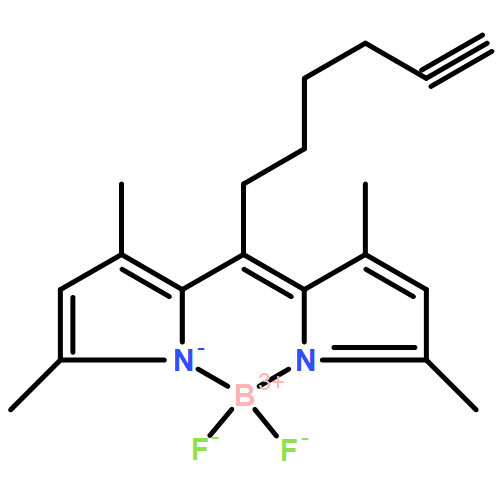Co-reporter: Jianbing Jiang, Wouter W. Kallemeijn, Daniel W. Wright, Adrianus M. C. H. van den Nieuwendijk, Veronica Coco Rohde, Elisa Colomina Folch, Hans van den Elst, Bogdan I. Florea, Saskia Scheij, Wilma E. Donker-Koopman, Marri Verhoek, Nan Li, Martin Schürmann, Daniel Mink, Rolf G. Boot, Jeroen D. C. Codée, Gijsbert A. van der Marel, Gideon J. Davies, Johannes M. F. G. Aerts and Herman S. Overkleeft
pp: 2782-2789
Publication Date(Web):09 Feb 2015
DOI: 10.1039/C4SC03739A
GH29 α-L-fucosidases catalyze the hydrolysis of α-L-fucosidic linkages. Deficiency in human lysosomal α-L-fucosidase (FUCA1) leads to the recessively inherited disorder, fucosidosis. Herein we describe the development of fucopyranose-configured cyclophellitol aziridines as activity-based probes (ABPs) for selective in vitro and in vivo labeling of GH29 α-L-fucosidases from bacteria, mice and man. Crystallographic analysis on bacterial α-L-fucosidase confirms that the ABPs act by covalent modification of the active site nucleophile. Competitive activity-based protein profiling identified L-fuconojirimycin as the single GH29 α-L-fucosidase inhibitor from eight configurational isomers.
Co-reporter: Jianbing Jiang, Wouter W. Kallemeijn, Daniel W. Wright, Adrianus M. C. H. van den Nieuwendijk, Veronica Coco Rohde, Elisa Colomina Folch, Hans van den Elst, Bogdan I. Florea, Saskia Scheij, Wilma E. Donker-Koopman, Marri Verhoek, Nan Li, Martin Schürmann, Daniel Mink, Rolf G. Boot, Jeroen D. C. Codée, Gijsbert A. van der Marel, Gideon J. Davies, Johannes M. F. G. Aerts and Herman S. Overkleeft
pp: NaN2789-2789
Publication Date(Web):2015/02/09
DOI: 10.1039/C4SC03739A
GH29 α-L-fucosidases catalyze the hydrolysis of α-L-fucosidic linkages. Deficiency in human lysosomal α-L-fucosidase (FUCA1) leads to the recessively inherited disorder, fucosidosis. Herein we describe the development of fucopyranose-configured cyclophellitol aziridines as activity-based probes (ABPs) for selective in vitro and in vivo labeling of GH29 α-L-fucosidases from bacteria, mice and man. Crystallographic analysis on bacterial α-L-fucosidase confirms that the ABPs act by covalent modification of the active site nucleophile. Competitive activity-based protein profiling identified L-fuconojirimycin as the single GH29 α-L-fucosidase inhibitor from eight configurational isomers.
Co-reporter: Lianne I. Willems ; Thomas J. M. Beenakker ; Benjamin Murray ; Saskia Scheij ; Wouter W. Kallemeijn ; Rolf G. Boot ; Marri Verhoek ; Wilma E. Donker-Koopman ; Maria J. Ferraz ; Erwin R. van Rijssel ; Bogdan I. Florea ; Jeroen D. C. Codée ; Gijsbert A. van der Marel ; Johannes M. F. G. Aerts ;Herman S. Overkleeft
pp: 11622-11625
Publication Date(Web):August 8, 2014
DOI: 10.1021/ja507040n
Lysosomal degradation of glycosphingolipids is mediated by the consecutive action of several glycosidases. Malfunctioning of one of these hydrolases can lead to a lysosomal storage disorder such as Fabry disease, which is caused by a deficiency in α-galactosidase A. Herein we describe the development of potent and selective activity-based probes that target retaining α-galactosidases. The fluorescently labeled aziridine-based probes 3 and 4 inhibit the two human retaining α-galactosidases αGal A and αGal B covalently and with high affinity. Moreover, they enable the visualization of the endogenous activity of both α-galactosidases in cell extracts, thereby providing a means to study the presence and location of active enzyme levels in different cell types, such as healthy cells versus those derived from Fabry patients.
Co-reporter: Paul P. Geurink ; Wouter A. van der Linden ; Anne C. Mirabella ; Nerea Gallastegui ; Gerjan de Bruin ; Annet E. M. Blom ; Mathias J. Voges ; Elliot D. Mock ; Bogdan I. Florea ; Gijs A. van der Marel ; Christoph Driessen ; Mario van der Stelt ; Michael Groll ; Herman S. Overkleeft ;Alexei F. Kisselev
pp: 1262-1275
Publication Date(Web):January 15, 2013
DOI: 10.1021/jm3016987
Proteasomes degrade the majority of proteins in mammalian cells by a concerted action of three distinct pairs of active sites. The chymotrypsin-like sites are targets of antimyeloma agents bortezomib and carfilzomib. Inhibitors of the trypsin-like site sensitize multiple myeloma cells to these agents. Here we describe systematic effort to develop inhibitors with improved potency and cell permeability, yielding azido-Phe-Leu-Leu-4-aminomethyl-Phe-methyl vinyl sulfone (4a, LU-102), and a fluorescent activity-based probe for this site. X-ray structures of 4a and related inhibitors complexed with yeast proteasomes revealed the structural basis for specificity. Nontoxic to myeloma cells when used as a single agent, 4a sensitized them to bortezomib and carfilzomib. This sensitizing effect was much stronger than the synergistic effects of histone acetylase inhibitors or additive effects of doxorubicin and dexamethasone, raising the possibility that combinations of inhibitors of the trypsin-like site with bortezomib or carfilzomib would have stronger antineoplastic activity than combinations currently used clinically.


